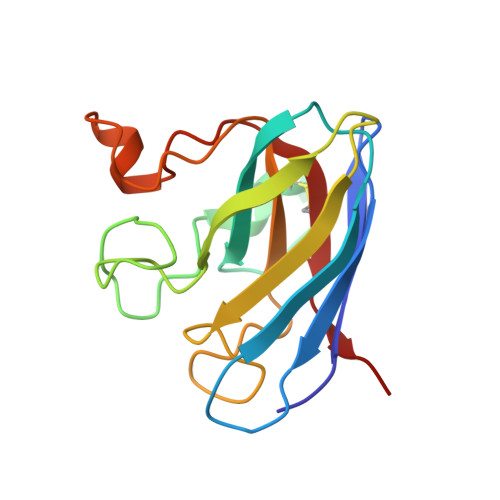Structural consequences of cysteinylation of cu/zn-superoxide dismutase.
Auclair, J.R., Brodkin, H.R., D'Aquino, J.A., Petsko, G.A., Ringe, D., Agar, J.N.(2013) Biochemistry 52: 6145-6150
- PubMed: 23919400
- DOI: https://doi.org/10.1021/bi400613h
- Primary Citation of Related Structures:
4FF9 - PubMed Abstract:
The metalloenzyme Cu/Zn-superoxide dismutase (SOD1) catalyzes the reduction of superoxide anions into molecular oxygen and hydrogen peroxide. Hydrogen peroxide can oxidize SOD1, resulting in aberrant protein conformational changes, disruption of SOD1 function, and DNA damage. Cells may have evolved mechanisms of regulation that prevent such oxidation. We observed that cysteinylation of cysteine 111 (Cys111) of SOD1 prevents oxidation by peroxide (DOI 10.1021/bi4006122 ). In this article, we characterize cysteinylated SOD1 using differential scanning fluorometry and X-ray crystallography. The stoichiometry of binding was one cysteine per SOD1 dimer, and there does not appear to be free volume for a second cysteine without disrupting the dimer interface. Much of the three-dimensional structure of SOD1 is unaffected by cysteinylation. However, local conformational changes are observed in the cysteinylated monomer that include changes in conformation of the electrostatic loop (loop VII; residues 133-144) and the dimer interface (loop VI; residues 102-115). In addition, our data shows how cysteinylation precludes oxidation of cysteine 111 and suggests possible cross-talk between the dimer interface and the electrostatic loop.
- Departments of Biochemistry and Chemistry and Rosenstiel Basic Medical Sciences Research Center, Brandeis University , Waltham, Massachusetts 02454, United States.
Organizational Affiliation:



















